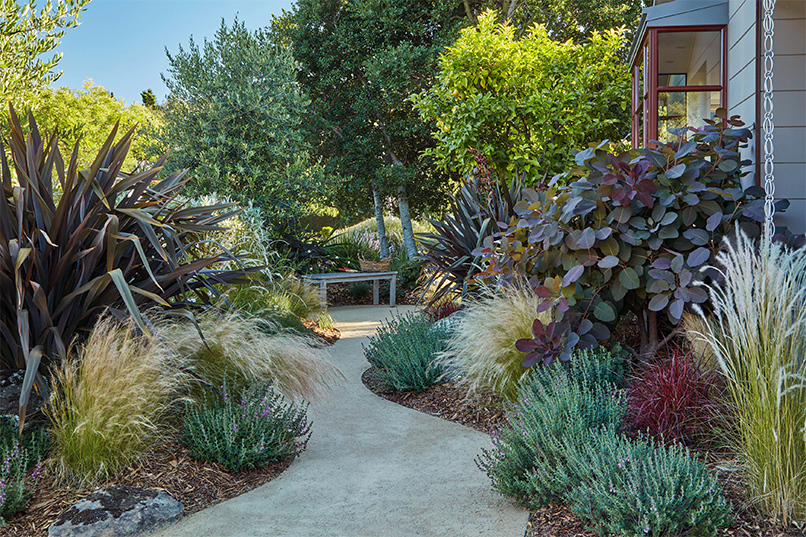Eight garden trends that we expect to emerge in 2023
This time, gardening will focus on vibrant colour, making a large impression in a tiny space, and local businesses. The next question is what to do to enjoy these theatre fads.

1. Shops that are smaller but better
Gardeners are looking for top-performing stores with a strong presence in response to the erratic frugalness. They’re searching for a single factory that can anchor a vessel or a significant portion of a planting bed rather than filling a vessel with four to six distinct annuals. These idler shops typically cost less than half as much as a mixed planting while still making a dramatic impression.
As an example, many of the new begonias grow quickly to fill a huge container and bloom continuously with essentially little care. The Ball Horticulture Hula begonia is one that has us very upset for 2023. It will grow in sun or shade and blooms nonstop the entire growing season.
2. Magenta Flowers 2.
Every time, Pantone, a business that specialises in colour, names the hue du jour. In 2023, Viva Magenta rules supreme. According to experts, this subtle berry-red shade is strong, brave, and pullulating with delight. Viva Magenta, which strikes a balance between warm and cold, was motivated by the cochineal beetle’s blood-red pigment. Its impact extends beyond internal barriers and fills your theatre with joyful energy.
Many exciting newer varieties, such as “hint Burgundy Double” enthusiasm, “Titan Cranberry” vinca, and “Ka- Pow Pink” theatrical phlox, can give the energy of magenta to your containers and beds.
3. Support local retailers
There are fewer and fewer challenging rainfall conditions for gardens around the nation, from storms to unidentified famines to extreme cold waves. Why natives then?
Pick stores that are indigenous to your area (such as those from the Southwest, Midwest, Northeast, etc.) and match them with the distinctive growing environments there. For instance, if you have a bog area with dappled light, seek for species that thrive in wet shade. You can definitely ask your state Extension service, native factory associations, or original botanic auditoriums for ideas.
4. Plenty of indoor plants
The popularity of indoor plants is still rising. There are constantly new stores to add to your collection, regardless of whether your house has turned into an interior rainforest or you wish to bring a fresh splash of greenery to every space. Finding interesting inner shops has never been simpler, from miniature monsteras to an abundance of pothos.

5. Grow a Tree
Trees continue to be an obvious strategy to combat climate change in addition helping local businesses. In 2022, community and nonprofit organisations with increased resources grew a tree-planting business. By planting a new tree this year, you may bring that passion to your own backyard. If you don’t have much room, try looking for a slender, upright cultivar of your favourite species. While planting trees, always remember the golden rule: right tree, right site, right technique.
6. The cutting edge of theatre design
2023 is growing for Cornucopia shops with cosmetic prices and sought-after ecological attributes. Consider oak trees as an example. They provide a food supply for pollinators, shelter for a generous fun and games location, and a sanctuary for wildlife. Berry backwoods offer enticing interest and exquisite fruit, much like the boat-friendly Bushel and Berry series. Dwarf figs are an excellent food supply for small civic auditoriums because they generate an abundance of rich brown fruit and grow to only 28 elevation altitudinous and wide. These dependable businesses combine to create a rich geography.
7. Autumn Planting
As low temperatures become the norm, the season for outdoor gardening need not come to an end. More and more fall-friendly factory options for both colour and food crops are being offered by garden centres. Get a packet of seeds and create a plantation for the hereafter. Get some cosmetic kale and a flat of colourful pansies to spruce up your hallway when the leaves change.
Twist in colours by Jo Thompson
I ’m seeing in guests an ever- adding amenability to consider further soft, as opposed to hard, landscaping planting areas coming up to the house with a sensible quantum of sundeck space for dining, and veritably much moving down from the notion of sweeping sundecks across the reverse of the house simply for the sake of it. This is right across the board, from small auditoriums through to larger plots; the idea of flashing, paved flashiness is forcefully out of the window.
My planting style has always been natural and romantic, and I ’m pleased to see that this is now considered mainstream. The key to the visual success of this approach is an informed use of colour. I ’m presently working on a lot of factory- driven geographies, where the shifts of colour are crucial to the success of the planting seasonal changes from unfolding bulbs through shrub roses and also hydrangeas to afterlife leafage colour, with a focus on atmospheres created through careful factory choices.
While social media will always have its place, the hunt for the perfect picture can occasionally undermine the confidence of newcomers, and so I ’m pleased when I come across accounts and newsletters whose content is more authentic. My own The Gardening Mind, available on Substack, is intended as an honest and open discussion, commodity that more and more people are relieved to find.

Hearts and Gardens by Kristina Clode
In recent times, numerous people have been reawakened to nature and the value of their out-of-door space, and are willing to invest not only in a beautiful theater , but in one with a heart. Creating biodiverse territories for wildlife, gardening using organic principles and sympathetic ways, planting the right factory
in the right place to cut down or exclude soddening altogether, and using original and natural accoutrements that have a reduced- carbon footmark and can be fluently reclaimed repurposed at the end of their life, are all decreasingly important. My natural auditoriums use an instigative blend of native and fantastic shops that protract the season of interest, while allowing tone- planted wildflowers in spaces between shops, encouraging naturalness and reducing the need for weeding. I frequently include imperishable wildflower meadows in auditoriums , which support huge quantities of life, subtly change over time and only need to be cut formerly a time.
Out-of-door living by Pollyanna Wilkinson
I’ve noticed a real shift in how important people value and interact with their auditoriums . The mindset of the theater as an afterthought has been replaced with a festivity of the vast eventuality that out-of-door spaces and auditoriums offer. guests now look to maximise the eventuality for out-of-door living in ways that suit their specific cultures and precedences. As similar, auditoriums are getting more acclimatized in terms of use – whether it be a space for parties and amusing or for solitariness and retreat. And despite( or maybe because of) the changeable British rainfall, we’re seeing further interest in making the theater more useable throughout the time, with requests varying from covered cuisine and dining spaces, to cosy recesses and fireplaces for the cooler months.







